Advanced Spin Resonance Facility Accelerates Fundamental Understanding of Catalytic Mechanisms and Structural Characterization at Level of Electrons
Understanding Control of Electronic Structure and Reaction Kinetics in Enzymes, Catalysts, and Materials Is Critical to Advancing Low-Cost and Efficient Clean Energy Technologies
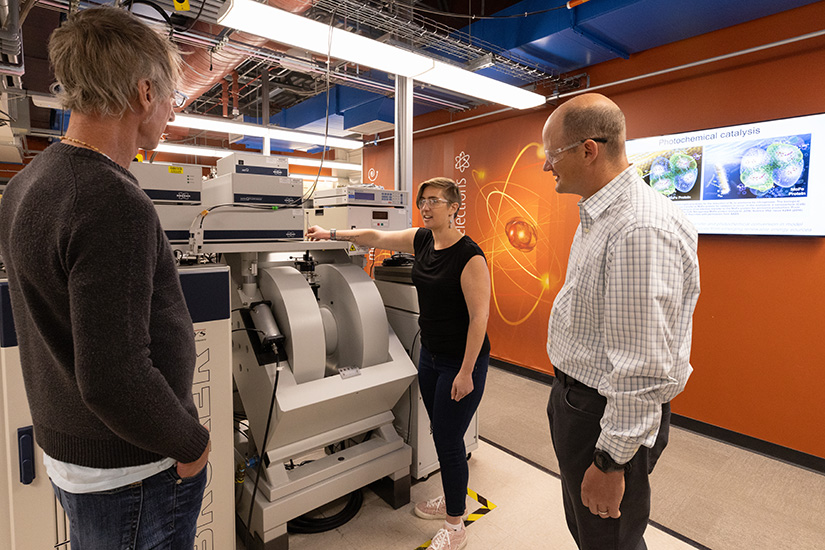
NREL researchers (from left) Paul King, Effie Kisgeropoulos, and David Mulder talk in front of the electron paramagnetic resonance spectrometer in NREL’s Advanced Spin Resonance Facility in Golden, Colorado. Photo by Gregory Cooper, NREL
Demystifying the fundamental processes of how organisms control energy at the level of electrons is key to advancing the applied research and development of systems for generating sustainable low-carbon fuels, chemicals, and electricity.
Success in this endeavor has been enabled by technical advances in electron paramagnetic resonance (EPR) spectroscopy, which provides insight into the most basic energy carrier and unit, the electron.
Compared to more well-known nuclear magnetic resonance (NMR) spectroscopic approaches that probe at the nuclear level, EPR probes at the electron level. EPR tools and techniques for examining and characterizing the electronic and structural properties of enzymes are generating new insights into fundamental energy conversion mechanisms.
Realizing the need and opportunity to probe deeper into the mysteries of the chemical reactions that sustain photosynthesis and enable light-driven ammonia production and hydrogen catalysis, the National Renewable Energy Laboratory (NREL) formed the Advanced Spin Resonance Facility at its Golden, Colorado campus.
Electron Paramagnetic Resonance Research Finds a Home at NREL With Assistance From DOE’s Office of Science
The early vision for the Advanced Spin Resonance Facility (ASRF) was to leverage cutting-edge EPR techniques to expand NREL’s research portfolio in the U.S. Department of Energy’s (DOE’s) Office of Science Basic Energy Sciences (BES) biological programs while strengthening NREL’s competitive edge in basic to applied science programs.
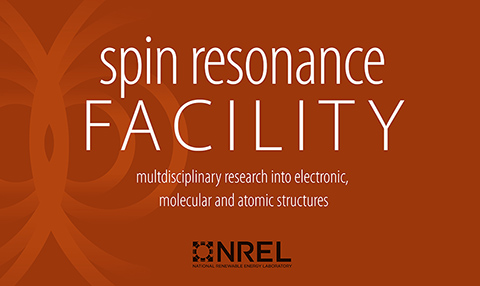
This vision came to fruition in 2015 through investments of funds by NREL to acquire a state-of-the-art EPR spectrometer and to create the ASRF to house the capabilities.
In 2020, BES contributed support to the ASRF by issuing an equipment funding award to NREL that provided critical technical upgrades and expansion of EPR capabilities to ensure the facility maintains risk-free operation well into the future and stays at the forefront of technological development.
Maureen McCann, director of the Biosciences Center at NREL, noted the importance the ASRF has had to NREL research.
“Without this facility, we just wouldn’t be able to probe the mechanisms of intermolecular and intramolecular electron transfer in enzyme complexes,” McCann said. “The support of the ASRF from BES has been critical to these fundamental studies.”
Peering Into Secrets of Electronic, Molecular, and Atomic Structures
Using the EPR spectrometers available at the ASRF, researchers can probe subatomic, electronic, and magnetic properties of biological and chemical materials relevant to catalysis, energy transfer, and conversion. How is this possible? The key is in the combined use of microwaves and magnets.
Essentially, an EPR instrument is a high-tech, microwave-assisted magnetic resonance system that provides glimpses down to the most basic level of how components and materials control electrons. An EPR instrument is analogous to a magnetic resonance imaging machine used in the medical world, except that it takes spectroscopic snapshots of electrons.
The ASRF aligns with the BES mission of supporting fundamental research to understand, predict, and ultimately control matter and energy at the electronic, atomic, and molecular levels. Understanding how electrons are controlled provides a critical foundation for advancing new clean energy technologies.
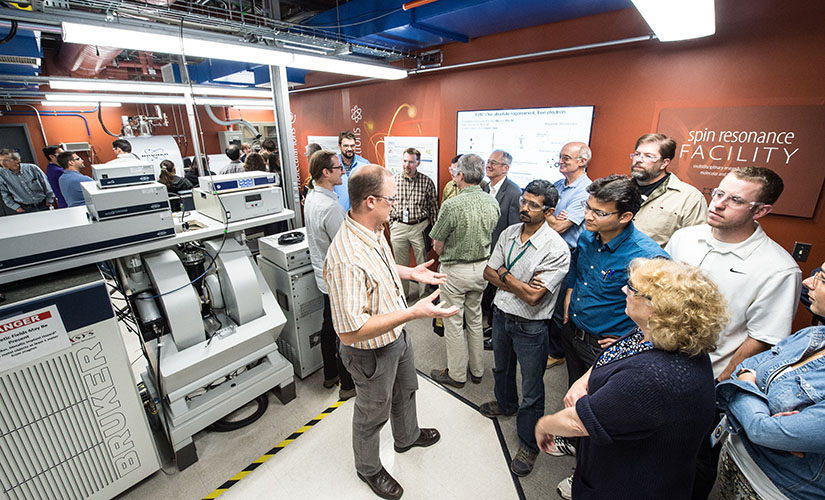
NREL scientist David Mulder (center) explains electron paramagnetic resonance capabilities to staff at the Advanced Spin Resonance Facility in Golden, Colorado. Photo by Dennis Schroeder, NREL
NREL researchers David Mulder and Effie Kisgeropoulos are leading efforts to build out, maintain, and manage the ASRF for NREL and university research partners in support of translating basic energy science research to applied research. The recent addition of Kisgeropoulos as a staff member with expertise in EPR came at an especially critical period for meeting the increasing user demand for instrument time.
Kisgeropoulos’ experience with EPR, which includes serving on the user committee of the National High Magnetic Field Laboratory, provides a unique resource for new users trying to apply EPR in their research and for others who would just like a technical helping hand.
“There are a lot of technical considerations that go into both data collection and analysis that can make it seem very intimidating,” Kisgeropoulos said. “But that’s a gap that I’m very much interested in helping to bridge, because I absolutely love working with people and helping with the application of EPR to their research. Plus, as a fundamental scientist, it’s really fulfilling engaging with all the exciting research happening at NREL and with our partners. There’s always a new problem walking in the door to be solved, and it’s exhilarating.”
The growth of the facility is notable, especially with the high number of younger scientists using it for research.
“It has been a tremendous opportunity to help manage this facility and watch the evolution and diversity of research to advance clean energy on all fronts,” Mulder said. “It took a massive community effort to make this facility happen, and it really has propelled us into new frontiers of science.”
Mulder recalls early research days at NREL when a mishmash of EPR equipment occupied a corner of another laboratory and it was technically challenging to carry out what are now considered routine measurements. Although plans to create a new facility were evolving, it took all kinds of people coming together to make it a reality.
NREL senior leadership stood by the vision for the facility, with Adam Bratis, associate laboratory director of the Bioenergy Science and Technology Directorate, and Mark Davis, the former Biosciences Center director, helping to secure general-purpose equipment funding to realize the creation of the facility.
Likewise, NREL Facilities and Research Operations, along with a team of engineers led by Group Research Manager Brent Nelson, were critical to designing and implementing the technical infrastructure to support the operation of the specialized equipment. In 2015, the facility officially opened with a ribbon-cutting ceremony officiated by NREL Director Martin Keller.
The Engines of the ASRF: Spectrometers
The facility houses two EPR instruments, a Bruker ELEXSYS E500 and a Bruker ELEXSYS E580 spectrometer. Together, the instruments are equipped with continuous-wave and pulsed capabilities, including:
- Multifrequency (X- and Q-) microwave bands for assessing the electronic properties of any material that possesses an unpaired electron, such as metal centers, radical species, and defect centers.
- On-demand, low-temperature capabilities that circumvent the need for expensive liquid helium.
- Photoexcitation and time-resolved collection to probe reaction intermediates and track the progression of electron transfer and catalytic reactions.
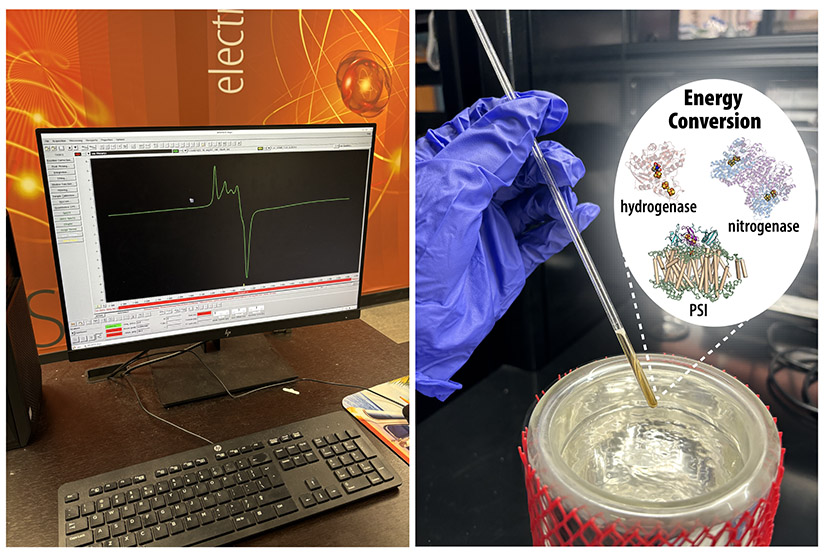
The Advanced Spin Resonance Facility provides data readouts (left) with information on the electronic-structural fingerprints of metal centers found in diverse materials, such as photosystem I (PSI) and metalloenzymes (right) like hydrogenase and nitrogenase that function in biological energy transformation. Read more in the Journal of Biological Chemistry about how research at NREL is utilizing electron paramagnetic resonance approaches to understand how certain types of enzymes produce hydrogen. Images by NREL
The ASRF instruments further make possible the performance of advanced pulsed EPR techniques such as electron-nuclear double resonance (ENDOR) and hyperfine sublevel correlation (HYSCORE) spectroscopy. These advanced techniques examine how electron-nuclear structural interactions contribute to the functional properties of biological and synthetic catalysts.
The coupling of light sources for in-cavity illumination and time-resolved measurements makes a wide variety of light-driven experiments possible. In addition, specialized instrumentation enables temperature-controlled illumination of samples outside of the EPR cavity.
Paul King, a BES-funded researcher at NREL, has been a key champion of the facility since its inception and has been instrumental in its use to advance basic energy sciences research.
“The ASRF has been a fantastic resource here at NREL and beyond to assist researchers in aligning pressing science questions with unique EPR capabilities,” King said. “And the ASRF has been a key resource for studies on defining the underlying properties of iron-sulfur clusters that function in the mechanism of electron transfer and catalysis.”
“One example was enabling groundbreaking research on electron bifurcation that was supported through Biological Electron Transfer and Catalysis (BETCy), a BES Energy Frontier Research Center,” King continued. “The advances that were made under BETCy, together with ongoing work by BES Early Career Awardee and NREL researcher Cara Lubner on determining the energy landscape of electron bifurcation, were recognized in 2023 with a Royal Society of Chemistry Faraday Horizon Prize as seminal contributions to biological energy conversion.”
Enabling Clean Energy Research at NREL Through the ASRF
Perhaps the most unique aspect of the EPR equipment is that it provides a glimpse into the structure and properties of electrons. Electrons are arguably the most basic currency of energy transformation, whether it be biological production of hydrogen or solar conversion of light to electricity.
An example of the research the facility supports is the fundamental studies on how redox enzymes control the flow and conversion of electrons to reduced products and fuels, such as hydrogen or ammonia.
For NREL’s core nitrogen reduction program, the ASRF is making it possible to probe mechanistic details of one of the most essential energy transformation processes—biological nitrogen fixation—through biohybrid complexes that consist of nanoparticles and an enzyme called nitrogenase.
The project is resulting in the development of unique light-driven EPR capabilities and is creating new opportunities for visiting researchers. For example, University of Colorado Boulder graduate student Helena Keller is probing how enzymes control the directional flow of electrons through a DOE Office of Science Graduate Student Research (SGSR) fellowship.
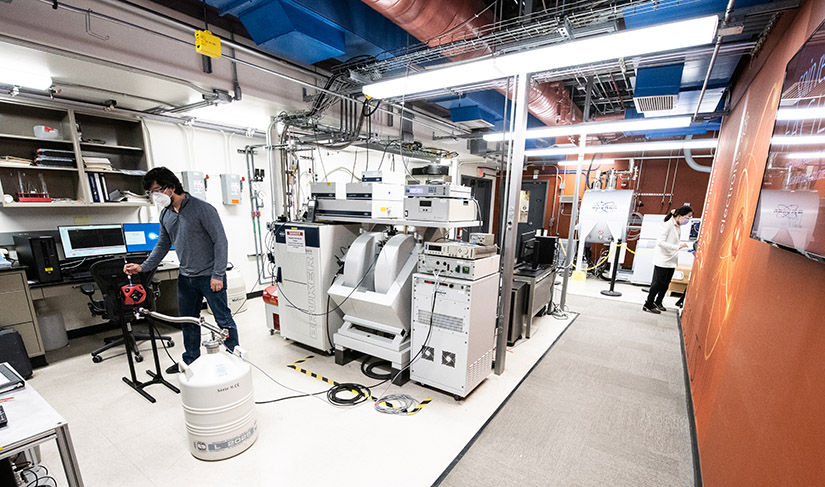
An NREL researcher illuminates a nanoparticle-enzyme hybrid sample to investigate the photocatalytic reduction of nitrogen to ammonia in biohybrid materials in the Advanced Spin Resonance Facility. Photo by Dennis Schroeder, NREL
The ASRF has been instrumental in advancing research on projects led by several principal investigators at NREL and in the Biosciences Center, including David Mulder, Cara Lubner, and Paul King. These projects are addressing fundamentally important questions on mechanisms of photosynthetic energy conversion, electron bifurcation, and photochemical nitrogen reduction. The latter aims to realize new light-driven systems for more efficient production of ammonia, a critical chemical used in fertilizers, plastics, and textiles. For these systems, the ASRF makes it possible to spectroscopically track how cadmium sulfide quantum dots can deliver electrons to the nitrogenase molybdenum-iron protein in the photochemically driven reaction.
Recent research in this area has provided new insight into the electronic characteristics and kinetics of the catalytic reaction intermediates of the iron-molybdenum cofactor active site that are integral to accomplishing the nitrogen reduction reaction, published in the Journal of the American Chemical Society and The Journal of Chemical Physics.
Through a recent Reaching a New Energy Sciences Workforce (RENEW) DOE Office of Science award led by Principal Investigator Megan Lazorski, assistant professor of chemistry in the Department of Chemistry and Biochemistry at Metropolitan State University of Denver (MSU Denver) and an NREL joint appointee, the ASRF is providing hands-on training opportunities to local undergraduate students at MSU Denver in research aimed at understanding the spin-state properties of manganese-based photocatalysts.
“Without David Mulder’s excellent training on the use of the ASRF facility, our students at MSU Denver wouldn’t be able to perform the work proposed in our RENEW grant, which investigates critical changes in the electron spin of earth-abundant manganese complexes in response to light,” Lazorski said. “After only five short months, our students are performing guided EPR experiments and creating high-level presentations on the theory and function of EPR equipment as well as the data they’ve collected.”
NREL chemistry researcher Justin Johnson primarily uses the Bruker E580 EPR instrument in the ASRF with its pulsed laser to photoexcite molecular crystals.
“The light-induced and pulsed EPR system in the ASRF has been a key component of our research to identify and characterize new quantum materials for potential sensing and computing applications, including understanding mechanisms of operation in a solar light harvesting device,” Johnson said. “The EPR technology that provides dynamical information about excited-state spins is relatively uncommon and enabled us to join the field rapidly and make substantive new insights.”
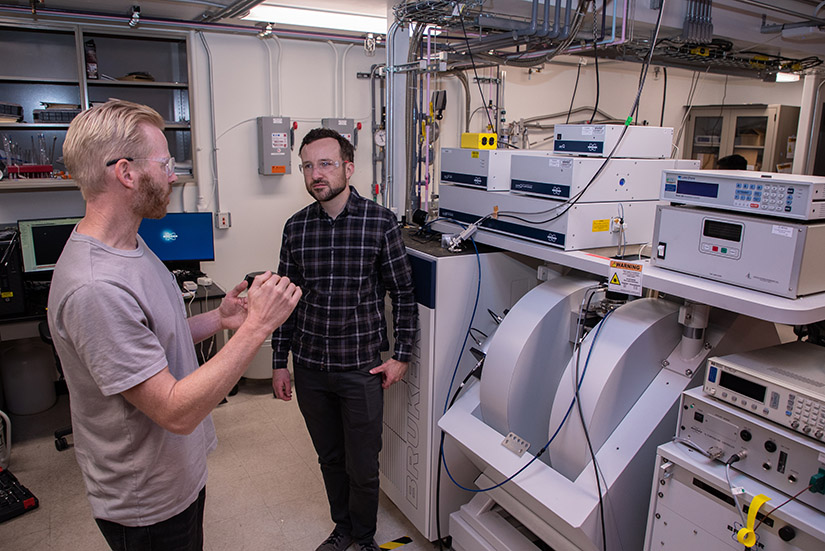
Researchers Justin Johnson (left) and Brandon Rugg (right) discuss quantum materials research in front of the spectrometer equipment in the Advanced Spin Resonance Facility. Photo by Joe DelNero, NREL
The ASRF Bridge Between Basic and Applied Science
The ASRF provides a unique research bridge between basic and applied science technologies through DOE Office of Energy Efficiency and Renewable Energy supported research.
This includes research led by the silicon photovoltaics team and Principal Investigator Pauls Stradins at NREL, through funding by the DOE Solar Energy Technologies Office, on developing extremely sensitive electrically detected magnetic resonance (EDMR) approaches to understand how defects in solar cells limit performance.
For lithium-ion batteries, the facility is supporting research funded by the DOE Vehicle Technologies Office to understand manganese cathode dissolution processes that are integral to performance.
The ASRF is also supporting research funded by the DOE Bioenergy Technologies Office to transform renewable carbon resources via catalysis as well as convert carbon dioxide to fuels and chemicals.
Building the Next Generation of Clean Energy Research Scientists
The ASRF has been instrumental in helping advance DOE clean energy research. Credit for the success of the ASRF can be given to the many early-career researchers who are creatively utilizing the facility to address science challenges while growing new project support. The ASRF provides unique training opportunities where students can gain hands-on experience with state-of-the-art equipment to help drive low-cost and efficient clean energy technologies.
Continued investment by BES in the facility can be attributed to recognition of its wide impact in energy science and its unique role in helping develop the next generation of researchers.
Reach out to David Mulder or Effie Kisgeropoulos for more information on the Advanced Spin Resonance Facility. Learn more about NREL’s basic energy sciences research.

